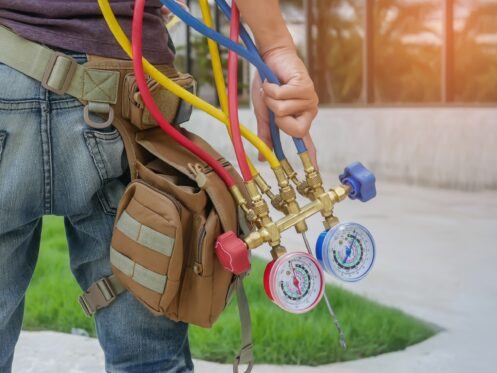Refrigerant is a necessary component of home air conditioners and heat pumps. Over the years, there have been many changes to the refrigerant types used inside of these systems to help ensure they’re safer for the environment. Below, we’re going to dive into some of the newer regulations to help you as a homeowner better understand how these regulation changes affect you.
The Past With R22
R22 refrigerant was a common component in HVAC units pre-2010. Over the years, it’s become overly clear that R22 refrigerant is damaging the ozone layer. More specifically, it releases chlorine into the upper atmosphere, which destroys the ozone molecules. Without an inadequate ozone layer, Earth will no longer be blocked from ultraviolet radiation from the sun. Additionally, R22 refrigerant has been deemed a greenhouse gas with a global warming potential, or GWP for short, over 1,800 times that of carbon dioxide.
The Environmental Protection Agency (EPA) is the governing body responsible for banning harmful refrigerants from production and use. In 2010, the EPA banned R22 refrigerant use in new HVAC equipment. They slowed down production and imports of R22 over a 10-year period. Beginning in January 2020, there was a complete ban on R22 usage in the country.
The Introduction of R410A
The biggest replacement for R22 refrigerant was R410A. This refrigerant is very common in many of the units homeowners have to date. R410A was an ideal replacement at the time for R22 because it offers better performance and doesn’t contain chlorine, which is a known problem that damages the ozone layer.
Since its introduction in 2020, R410A refrigerant has been shown to have a high global warming potential. In fact, R410A has a GWP of over 2,000, meaning it traps over 2,000 times more heat than carbon dioxide. While this is not damaging to the ozone layer like R22 refrigerant, it still contributes heavily to unwanted climate change.
American Innovation and Manufacturing (AIM) Act
The AIM Act was passed back in December 2020 as a method for phasing out hydrofluorocarbons (HFCs), which includes R410A refrigerant. This was done in an effort to reduce their global warming potential to better resist unwanted climate change. The goal of this program is to reduce HFC usage in the country by 85% between 2022 and 2036.
According to this new act, no new HVACs that use R410A refrigerant may be produced or imported into the country. The existing inventory of HVACs that use R410A refrigerant can still be installed until the inventory runs out. The EPA has set a phase-out schedule to reduce the production and import of R410A refrigerant between 2022 and 2036 until it will be completely banned from use. Once that happens, any AC installation service will have to provide systems that use the new refrigerant.
What’s Replacing It?
R410A refrigerant is being replaced with low-GWP refrigerants that are better for the environment. There are a few different refrigerants that fall into the A2L category of safe refrigerants, which are R32 and R454B. Both of these refrigerants have a global warming potential between 400 to 700, which is significantly less than their predecessor of R410A refrigerant.
These newer A2L refrigerants offer a higher operating efficiency. However, they’re considered mildly flammable, so extra safety precautions are made in the production process to accommodate for homeowner safety. Production of systems that use A2L refrigerants has been around since 2017 in the United States. However, many other countries, like Japan, have been using these newer refrigerants since the early 2010s with success.
How Do These Regulations Impact Your Current HVAC System?
One of the biggest concerns that many homeowners have when they hear about these new refrigerant regulations is how they will affect their existing HVACs. If your system was already installed prior to January 01, 2025, then you don’t have to do anything to meet current regulation standards.
You can continue to use your unit until it reaches the end of its life span and needs to be replaced. At that point, you’ll need to purchase a device that uses one of the new A2L refrigerants. It’s very important to note that the production of R410A refrigerant will decrease as the years go by. If your appliance needs to be recharged with this type of refrigerant, you can expect the price to go up as the supply dwindles.
New A2L Systems
There is a wide selection of new air conditioners and heat pumps that use the newer A2L refrigerants. Because HVAC manufacturers had to redesign these systems to accommodate the specifics of these newer A2Ls, their purchase price is higher than traditional HVACs using R410A refrigerant. It can be helpful to keep this in mind when saving for a unit replacement.
Retrofitting Older Systems
Another big question homeowners have from the increasing price of recharging R410A refrigerant and an urge to be more environmentally conscious is if they can retrofit their existing HVACs to use one of the newer A2L refrigerants. The answer is it depends on your existing setup.
Some existing heat pumps and air conditioners can be retrofitted successfully to use one of the newer R32 or R454B refrigerants. However, it’s essential to realize the retrofitting process may require a plethora of changes, like replacing the existing compressor, oil, and other internal components to ensure the proper functioning of the new refrigerant.
It’s highly advantageous to determine the total cost of the replacement parts for retrofitting your device, the remaining life span of your unit, and the cost of new units when determining whether retrofitting or replacement is the ideal option. It’s pretty typical for most homeowners to continue using their existing R410A appliances until they reach the end of their life spans.
Benefits of Upgrading
Making the decision to upgrade to a newer unit that uses one of the A2L refrigerants can come along with many great benefits. The most obvious is that you can reduce your contribution to global warming by using a system that has a much smaller impact on climate change than your existing unit.
Another notable benefit of using air conditioners and heat pumps with R32 refrigerant is they offer about 5 to 10% better energy efficiency than older R410A systems. This increase in efficiency is due to better thermodynamic properties that allow your unit to more effectively transfer heat. Systems that use R454B refrigerant can boost efficiency between 5 and 8% compared to R410A units.
Upgrading is also a great way to help prevent being blindsided by an increase in refrigerant prices whenever your unit needs to be serviced. Those who continue to run systems with R410A refrigerant can only expect stark increases in the price of refrigerant in the coming years. Apart from just the benefits of being more environmentally conscious and having a more energy-efficient unit, upgrading to one of these newer appliances is a great way to enhance your comfort and enjoy a brand-new warranty.
Reliable AC Installation Service
Environmental Heating & Air Solutions provides reliable AC installation service for the Roseville, CA community. We can also help with all your AC replacement, repair, and maintenance needs. Call us today to book your next service consultation.

